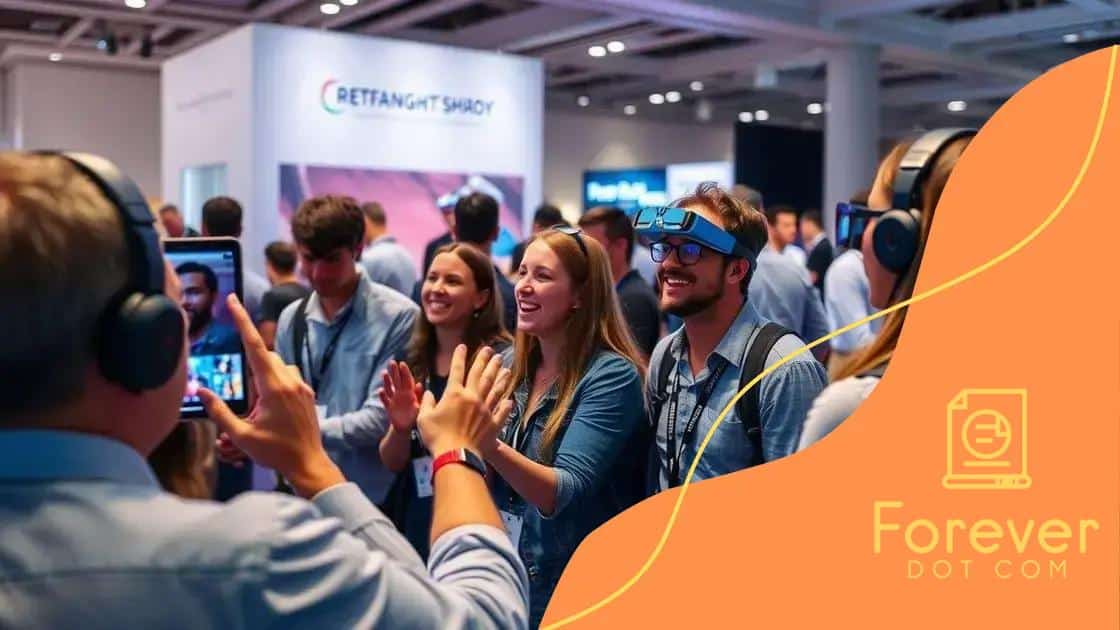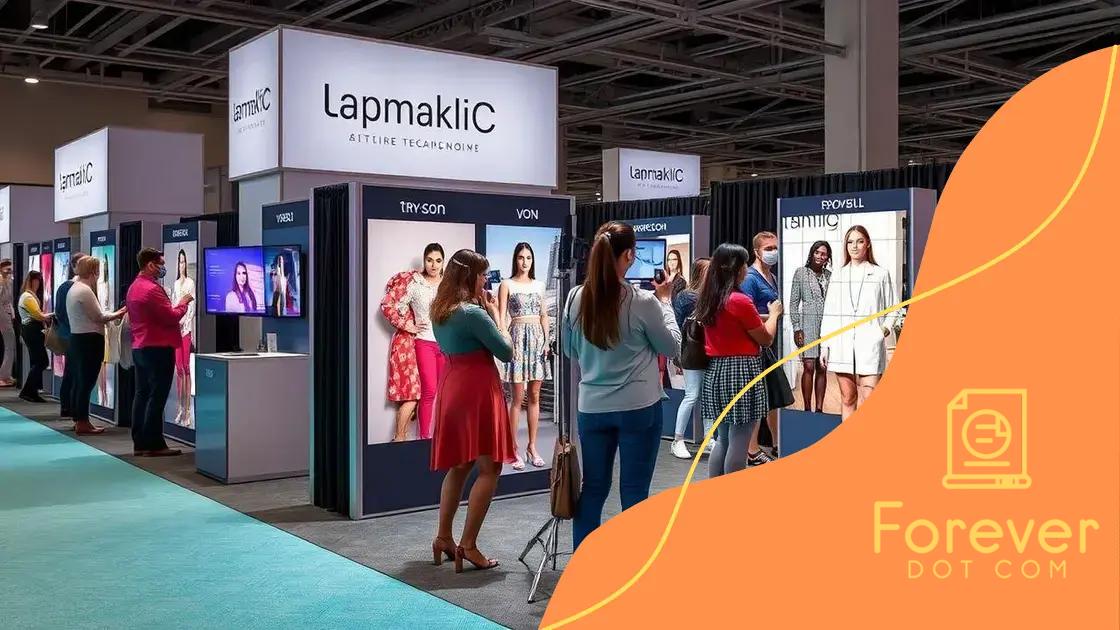The growing importance of virtual try-on technology at events

The growing importance of virtual try-on technology at events enhances customer engagement by allowing realistic product visualization, leading to increased satisfaction and reduced return rates.
The growing importance of virtual try-on technology at events is reshaping how attendees interact with brands. Have you ever imagined trying on outfits or accessories without leaving your home? That’s the magic of this innovative technology!
Understanding virtual try-on technology
Understanding virtual try-on technology is essential in today’s digital landscape. This innovative solution allows users to visualize products on themselves without physical interaction. Imagine being able to try on clothes or cosmetics from the comfort of your home.
What is Virtual Try-On Technology?
Virtual try-on technology uses augmented reality (AR) and artificial intelligence (AI) to superimpose virtual products onto a live camera feed. This offers a realistic view of how a product would look in real life. This technology helps consumers make informed decisions without needing to visit a store.
How It Works
- Users select a product they are interested in.
- The camera captures their image in real time.
- The software applies the selected product to the user’s image.
This process creates an engaging shopping experience that is interactive and fun. The virtual try-on experience can lead to better customer satisfaction.
Many brands are adopting this technology to enhance their retail strategies. For instance, cosmetics companies offer apps where users can try makeup virtually. Clothing retailers enable customers to see how different outfits fit without trying them on physically.
Benefits of Virtual Try-On
- Increased customer engagement and satisfaction.
- Reduced return rates by helping customers choose accurately.
- Enhanced brand loyalty through innovative shopping experiences.
As technology improves, the realism of virtual try-ons will only get better. This advancement opens doors for more brands to create immersive shopping environments, ultimately transforming how consumers shop.
How virtual try-on enhances event engagement
How virtual try-on enhances event engagement is becoming a game changer in the market. Through interactive experiences, attendees can connect with brands like never before. Imagine walking into an event and instantly trying on clothes or accessories using your own device!
Interactive Experiences
This technology creates a unique connection between customers and products. Attendees can visualize themselves wearing items they are interested in. This process makes shopping more personal and enjoyable, increasing excitement around the brand.
Attracting Attention
- Event organizers can draw in larger crowds.
- Interactive displays capture audience interest.
- Unique experiences lead to social media sharing.
Brands using virtual try-on technology at events often report higher levels of attendee engagement. Traditional booths may not attract attention in the same way. With AR, customers are invited to participate actively rather than passively observing.
When people use this technology to see how products look on them, they feel more involved. This involvement can boost brand loyalty. Moreover, satisfied attendees are more likely to share their experiences online, enhancing brand visibility.
Boosting Sales
- Encourages impulse purchases.
- Reduces hesitation by allowing virtual trials.
- Increases overall customer satisfaction.
By enhancing engagement, this technology can lead to higher sales at events. When consumers feel connected, they’re more comfortable making purchases. Thus, events become platforms not just for networking but also for profitable transactions.
Real-world applications of virtual try-on at events

Real-world applications of virtual try-on at events showcase how technology can transform the attendee experience. Brands leverage this innovation to engage their audience more effectively. Picture an event where guests can try on a variety of outfits using augmented reality!
Fashion Industry Innovations
In the fashion sector, brands are using virtual try-on technology to allow shoppers to see how clothes fit on them. This not only gives customers a better idea of size and style but also makes the shopping experience exciting and interactive.
- Customers can mix and match outfits.
- They can take selfies and share their looks instantly.
- Fashion influencers can showcase collections live.
By incorporating this technology, fashion events become more memorable and engaging. Attendees leave with a unique experience, making them more likely to recall the brand later.
Beauty and Cosmetics Applications
Similarly, the beauty industry benefits significantly from virtual try-on solutions. For instance, makeup companies offer virtual mirrors where guests can test different looks using their mobile devices.
- Customers create custom makeup palettes.
- Live demos can demonstrate products effectively.
- Instant feedback from peers enhances the fun.
This level of interaction invites attendees to experiment with products they might not have considered otherwise. Such applications elevate engagement, making brands memorable.
Retail Partnerships
Retailers partner with event planners to set up interactive booths featuring virtual try-on technology. These partnerships lead to enhanced foot traffic and a buzz around the event.
By integrating this technology, companies gain real-time insights into customer preferences. They can tailor experiences based on instant feedback from attendees, which optimizes future events.
Challenges in implementing virtual try-on
Challenges in implementing virtual try-on technology can impact a brand’s ability to fully leverage its benefits. While this technology offers exciting advantages, there are several hurdles to overcome. Understanding these challenges is the first step toward finding solutions.
Technical Difficulties
One significant challenge is the technology itself. Developing accurate and realistic virtual try-on features requires advanced software and hardware. The AR elements must seamlessly blend with real-life images to ensure a convincing experience for users.
- Creating realistic 3D models can be complex.
- Integration with existing platforms may be tricky.
- Ensure stability across different devices.
This complexity could lead to higher development costs and require specialized skills. Brands must carefully consider these aspects to provide a high-quality experience.
User Experience Concerns
Another hurdle lies in user experience. If the virtual try-on technology is not user-friendly, customers may not engage with it. People expect smooth navigation and quick results, or they might feel frustrated and abandon the process.
- Slow processing time can deter users.
- Complicated interfaces can overwhelm customers.
- Inaccurate representations can lead to dissatisfaction.
To address this, brands must conduct thorough testing and gather feedback to enhance usability. Ensuring that users find the system simple and rewarding is crucial for success.
Data Privacy and Security
Data privacy is also a significant concern when implementing virtual try-on technology. Collecting user data, such as images for fitting analysis, creates privacy risks. Users need assurance that their information will be secured and not misused.
Brands must comply with regulations and build trust with their customers. Clear communication about data usage policies helps alleviate concerns, making customers more willing to engage with the technology.
Future trends of virtual try-on technology
Future trends of virtual try-on technology suggest exciting developments that could enhance customer engagement even further. As technology progresses, businesses are likely to adopt new features to improve user experience and personalization.
Enhanced Realism
One major trend is the focus on making virtual try-on experiences more realistic. Companies are investing in better graphics and more detailed 3D models to ensure that users can see how products will truly look in real life. This heightened realism can significantly affect how consumers perceive products.
- Improved lighting effects for a more natural look.
- Advanced fabric simulations for clothing.
- Higher accuracy in facial recognition for makeup applications.
This emphasis on realism will likely reduce hesitation among customers when making purchasing decisions.
Integration with Social Media
Another emerging trend is the integration of virtual try-on technology with social media platforms. Imagine users sharing their virtual try-on results directly on their profiles. This feature can help brands reach broader audiences quickly.
- Users can showcase their virtual outfits or looks.
- Social media sharing can lead to increased engagement.
- Influencers can promote brands easily through virtual try-on experiences.
By harnessing social media, brands can create viral marketing campaigns that captivate a younger audience.
Artificial Intelligence and Personalization
The future will also see an increase in the use of artificial intelligence to personalize the virtual try-on experience. AI can analyze user preferences and recommend styles based on individual tastes.
This data-driven approach allows for a unique shopping experience tailored to each customer. Improved personalization also helps maintain customer loyalty as users feel more valued.
The future of virtual try-on technology holds great promise for consumers and brands alike. With advancements in realism, social media integration, and personalization, shopping experiences are set to become even more engaging and enjoyable. As brands address challenges and embrace these trends, customers will find themselves in exciting new environments that enhance their decision-making process. Overall, the evolution of this technology will continue to transform how people interact with products, making it a significant player in the retail landscape.
FAQ – Frequently Asked Questions about Virtual Try-On Technology
What are the main benefits of using virtual try-on technology?
Virtual try-on technology enhances customer engagement, reduces return rates, and creates a more personalized shopping experience.
How does virtual try-on technology work?
It uses augmented reality to superimpose virtual products onto a real-time image of the user, allowing them to visualize how items look on them.
What challenges do brands face when implementing this technology?
Brands often encounter technical difficulties, user experience concerns, and data privacy issues that must be addressed for successful implementation.
How is AI used in virtual try-on technology?
AI personalizes the virtual try-on experience by analyzing user preferences and recommending products that align with their style.






